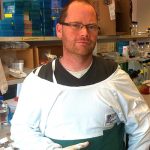Evidence suggests that sunlight can help protect against the development and progression of MS. Despite intense interest, the mechanisms by which UV provides this protection is not clear. It is thought to be via suppression of the immune system and this project will attempt to uncover how this occurs. Using laboratory models of MS, Dr Byrne will first test which immune cells are involved in sunlight protection from an autoimmune attack. In particular this project will focus on B regulatory cells, immune cells which dampen immune system responses.
Once the cell type is identified Dr Byrne will then go on to investigate the precise mechanisms underlying the sunlight protection mediated by those cells. This information will then be used to try and induce these cells in laboratory models of MS, to treat autoimmune attacks. If successful, this work will be an important proof-of-principle study, which will potentially form the basis of the new cell-based preventative and treatment option for autoimmunity.
This project aims to use both animal models and human laboratory-grown cells to identify the immune cells involved in the regulation of UV exposure during autoimmune inflammation. In particular, Dr Byrne and colleagues aim to determine which immune cells are responsible for the illness suppression that occurs when mice with MS-like illness are exposed to UV light, and which appear to be involved in protecting the brain from inflammation.
Dr Byrne and colleagues have found that depletion of a particular immune cell type, called B cells, within the laboratory model of MS, leads to an increase in MS-like illness – meaning that these cells are involved in mediating the protection conferred by UV light. Dr Byrne will now use this information to design and test a new immune based preventative and treatment option.
The team have also made progress on addressing the overall hypothesis that UV-protection from the MS-like illness is mice is due to the action of a regulatory cell. While they have showed that regulatory cells are required for protection from autoimmune attack, unexpectedly, further experiments have shown that factors must also be at work in the overall system. This implies that UV light is affecting distant tissues in ways that are separate from, and yet complimentary to regulatory cell activation.
Additional experiments aim to determine whether artificially-activated human immune cells (called activated mast cells) may be a potential means for reducing inflammation in the brain. This platform has now been setup in the laboratory and early results have indicated that microparticles are present on these activated mast cells, and are able to influence the immune system B cells, which may be useful for alleviating immune attacks. Dr Byrne and colleagues are undertaking further work to consolidate this exciting finding, which represents a new avenue of research into possible treatments aiming to reduce damage and lesions in the brain in MS.
Together the experiments conducted in this project will form an important proof of principle foundation for the future development and translation of new cell-based treatment options for MS patients.
Updated: 20 April 2015
Dr Scott Byrne
$300,000
2013
3 years
Past project

